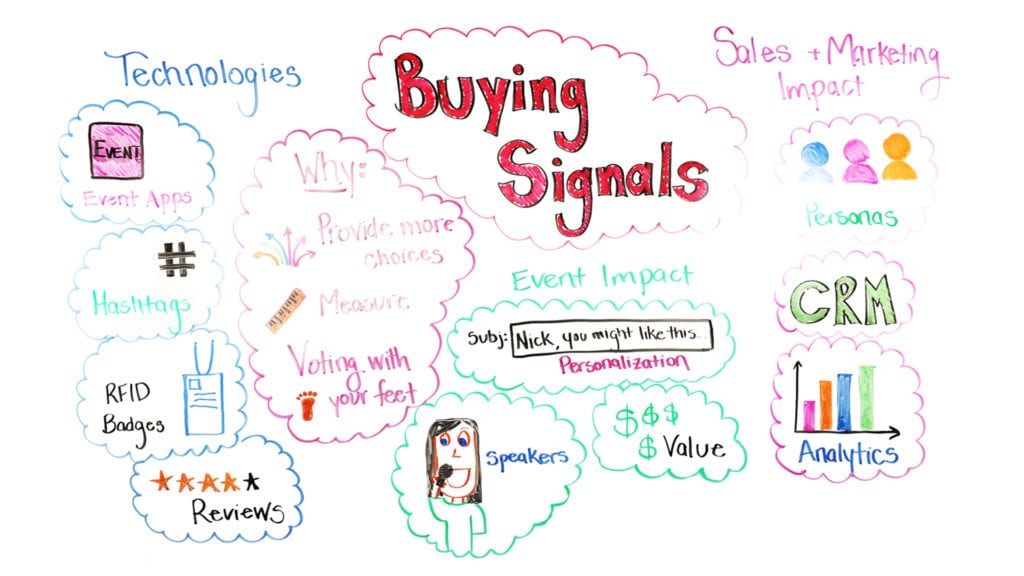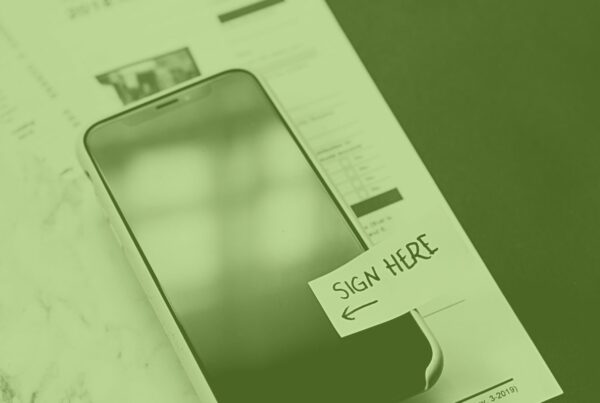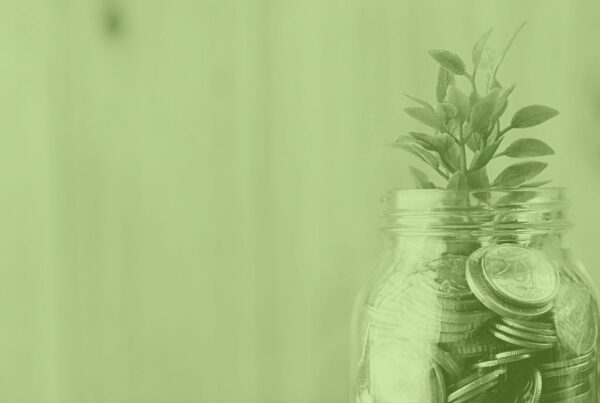It’s time for our weekly dose of Whiteboard Wednesday, and this time around, it’s all about buying signals. Because you’ve probably been in the industry for a while, you know that the bottom line is all about people. And how many times do you find yourself brainstorming ways to make events better for your attendees? Or how to choose the right sponsorships? How to deliver the highest value to every single stakeholder involved in your event?
This is precisely where buying signals can come in handy. Observing and analyzing the behaviors of the people your event is targeted to, or that somehow matter for your business, is a full-proof way to achieve your goals. After all, decisions based on data and unbiased observations are a literal gold-mine. Join our always lovely host Nick Borelli as he explains what buying signals are and exactly how you can make the most of it. Let’s get rolling with today’s Whiteboard Wednesday!
Video Transcription – Buying Signals
Hi everybody. This is whiteboard Wednesdays. I am Nick Borelli and I am here to talk to you about buying signals. If this is not something that is coming out of your mouth often in the planning process, that’s okay. It’s not uncommon. I happen to be someone who says it a lot, mostly because I have one foot in the world of marketing, one foot in the world of events. And I see where these two things are interconnected. In a way that was really a lot more valuable than a lot of other people looks at the different buying signals that are available online.
What’s The Gist?
I think one of the most powerful, if not the most powerful export besides great experiences, maybe even better than that of attending an event, are buying signals. And what that means is what your attendees are telling you about their behaviors. That can result in improved sales and conversion somewhere down the line for someone. This could be stakeholders. It could be for you directly. Or it could be for associations having a better understanding of their membership. This could be user conferences, having a better understanding of your clients. There are lots of different insights that you can gain by paying attention to what attendees do specifically when attendees have options.
Going About It
So what that means is you provide them choices at different points of the event. And you pay attention to which way they go. It’s not much more complicated than that. Except for how you actually do it, which is the technologies, and we’ll get to that in a second. But really you provide A, B, C, D, however many opportunities you have at any given period of time. You find out some way to measure that. And then you consider the value of that as related to the idea of voting with your feet. Now on the internet, there are lots of talks about clicks. So how do I get them to click this? And what’s the click-through rate? And what’s the view through rate?
I’m going to tell you that as far as signals are concerned, as far as data is concerned, that’s not nearly as powerful as voting with your feet. That’s someone saying, “The choice I’m making here is wrapped up in thousands of dollars that I spent to attend, to fly out to find a babysitter. Whatever you have to do to be at this event. And then look at all the things you have to do. You could be outside at a pool, you can be at this cool new location. Or you could be going to this networking component. You could have a meeting with somebody, there are four different sessions. Or you can stay in your hotel and sleep in. There are all these different options you have as an attendee in any given hour and a half and you chose to do this.
Finding The Patterns
And when you measure that amongst the whole groups of people, then you start looking at these trends. What you find is that you’re learning a lot about how people want to spend their time and really that’s their most valuable resource. I mean the resource of click-through is just this much time. The amount of saying “I’m going to spend an hour and a half listening to one speaker in a room where I have to look at that person face-to-face.” That’s a real investment and that’s something that you should pay attention to beyond just the event itself.
Now the reason that this has not been on the lips of every event professional for the last 30 40 years prior to to the last 10 years. It’s that there really hasn’t been enough technologies until recently to monitor what people are doing. How they’re voting with their feet. There are a ton more opportunities to do that now with further and further sophistication of event technologies. Including things like event apps. People choose the sessions that they are going to go to, but they don’t necessarily go to those. They might go to another one, and that tells you something. Their aspirational opportunities versus what they actually did, what disrupted that? So there are lessons to learn and data there.
#Buying Signals
Things like hashtags. What were the words in a word cloud, let’s say, that people tweeted the most during this period of time? What resonated the most with that speaker as people saw them in the keynote? Valuable information. Who did it the most? As far as the people at your show who were the most prolific. Things like that are very interesting as well. RFID badges, the beacons that are at events that track where attendees are moving, that tells you a ton of information. Did they spend an inordinate amount of time at the coffee station? Was there a fair amount of people that just drank coffee the entire time? That’s something to know. You can design a better experience. Or you might be able to have a coffee sponsor next year. You might be able to, in your CRM hit them up with coffee-related subject lines. Lots of information that you can gather from that individual or in trends from the group by and large.
Reviews
And the last bit is the reviews. When someone goes to a session and they say “I thought this, I thought that,” or “This was really engaging or there wasn’t any water at the station,” or whatever it is. That qualitative thing kind of goes against the quantitative information that you have as far as where people go around in the event with the beacons. So at every step of the experience itself, you have the opportunity to kind of gauge where people are, what they’re doing and how they’re feeling. I will even say that there’s the future of this and it’s the present too. But it will be more pervasive in the future. Things like sentiment analysis, biometric feedback with wearables, biometric feedback with micro-expressions on cameras. There are tons and tons of new technologies that are out there to gauge how people are experiencing your event. Because people want to use that measurement in order to make better decisions outside of the event itself.
Harnessing The Power Of Buying Signals
So let’s talk about first how you can use that information to make a better event. Which event people are generally more interested in than maybe some of the other sales and marketing stuff. But let’s go to that first because I think you’ll like that better. You have the opportunity with this to use some personalization. So there’s an event and we know that let’s say everybody who attended this one session or these groupings of sessions and also gave it a high rating. So you run that report and you see that these are all the people who went to these sessions and also rated it five stars. Well, next year when you want them to come to your event. What you should do is, you know what they went to and that they liked it. You should include in the subject line and/or the body saying, “Here are three other sessions based on the sessions that you went to last year that I think you’re really like, and you should register now.”
Now that kind of personalization is really, really valuable. Because someone’s like, “Well they were right. I did like that. And if they’re going to deliver more on that, then they’re listening to me and they’re speaking my language and yeah, I think I will register next year.” And that’s an invaluable, valuable thing is retention. The opportunity to make sure that people see more of the things that they like.
The Design
The last bit is in the event impact really comes down to designing. So you can probably use this data to create maybe about 70%, let’s say, of the design of next year’s event based on information that last year was good. So last year you could say, “Okay, here’s the data that says what sessions they went to, what topics were valuable.” And you can say, “Well let’s bring this speaker back. Let’s have more sessions on this.” And really just kind of copy and paste the best of.
So the last bit of what you would interject in the design of an event might be, “Okay, what are the messages we’re trying to push this year? What’s really hot in the market, etc?” But the majority of the work is really done by just actually paying attention to how people voted with their feet and give them more of that. If it’s not broke, don’t try to fix it. And then just increasing the value proposition in general of your event by not just making things up from scratch. Basically taking the information and the lessons that you learned and not just throwing them away. And saying, okay let’s have a meeting again about what, who should we bring to the event or how we should get them there. Just make sure that you’re listening. Because that’s the event design itself and even the marketing based on paying attention to how people act at your event and not treating them like ghosts.
Buying Signals Matter
The last bit is the part that I think that event professionals probably do the least. And that is considered that the buying signals themselves are a means unto themselves and an exportable that is valuable beyond just the event needs. Either this year or next year. So the idea of being able to create better and better personas, super important. Because you know, okay this type of people who are this age and this seniority in the industry and also go to more events like this or spend more time on the show floor. Or spend more time in their hotel room. It’s all those like behavioral stuff that you can take with the demographic information that you have. And marry them together to create more actionable personas. That information is valuable for whatever you do outside of the event itself.
So if again, you’re an association, this is very valuable information about your membership. If you are a corporation, this tells you a lot about buyers. And maybe just buyers in general or your specific buyers. If it’s an invite conference or if there’s a sales opportunity. So if you have the ability to take information about anyone specific attendee themselves and okay, here are the trends that you saw within that person. So they’re more minded on the exhibition floor than they are sessions. Great. They went to more technology-driven sessions. OK. You put that into the CRM because frankly for salespeople, if it’s not in the CRM, it didn’t happen, and your event is just kind of something off to the side. But if the exportable of the event actually resides and has a legacy within the CRM platform, then your whole organization benefits from the information that it gathers and you can actually respond to that person down the line with information that you have about them and how they vote again with their feet.
Look At All This Data!
In addition to that, you have a lot of opportunities to look at analytics that are related to the entire marketplace. And you can use those as a sponsorship deliverable. So if someone’s a stakeholder in your event and you can say, one of the things you get as a sponsor does not only do you get your name put under some banner that says gold sponsor or whatever nonsense our industry does all the time. But give them something that’s really valuable that say, “Okay, here’s some insights that we gathered from these people that you can use in your marketing.” So you can design let’s say content marketing for the following year based on the types of content that they chose to see at the event.
So you’re not saying like, “What should we blog about? What kind of reports should we create?” You’re not just guessing. What you’re doing is you’re saying, “Well, this group who represents basically a crosssection of what would be our markets all decided that mostly they want to spend their time consuming this type of content. So this year let’s create more content like them and deliver that in order to quicken up our pipeline.”
Sponsors
That kind of information as far as the sponsor is concerned is really valuable. Too often than not, they just get all these kind of logo placements and not any actionable insights about their potential clients. Or they get an opportunity to sell to people in a 10 by 10 space. What about the other 364 days of the year? What do they get that this event could have given them? Well, that answer is buying signals.
So you need to be able to give to your sponsors as many of all of this information that you could put together in a report. And say, “Okay, now you can do what you do better. Not only did you get opportunities to meet them face to face, but we have gathered all this data that allows you to understand the clients that you have a little bit better so you can potentially have more effective marketing, more effective sales, and have a better understanding of who you’re speaking to every other day of the year.”
Conclusions
So that’s the idea of buying signals and how you collect them, why you do it, how it impacts your events and potentially how it impacts sales and marketing for your stakeholders. If you have any buying signals that you’ve either acquired from your events or if you, let’s say, are looking for some, let’s comment below. Because I’m really curious to see a different kind of buying signals that you measure and maybe some technologies that you used to gather them there. Because I’m sure there’s a myriad of new ones coming out every day. And don’t forget obviously to like and subscribe and we’re looking forward to seeing you next week.











